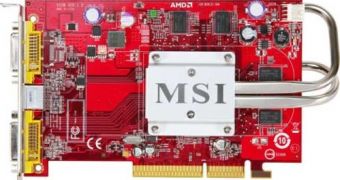In a world dominated by PCI Express graphics cards and multi graphics setups like the Nvidia's SLI or AMD/ ATI's CrossFire it looks as if there is still a quite strong demand for AGP based video cards. Nvidia, the green goblin of the graphics market, announced a long time ago that it dropped the AGP standard for good considering it obsolete but ATI stated that the old graphics standard still has some juice left as the number of computer users that never changed their graphics cards from AGP to PCI Express is huge. Well, as Nvidia left the AGP market for good it is time for AMD's graphics division to surprise AGP users with a new pretty high-end video card.
From all graphics card manufacturers and vendors around the world MSI is the first to announce the release of a new AGP card based on the ATI Radeon HD 2600 Pro graphics processing unit. The MSI card named RX 2600PRO-T2D256Z/D2 comes with standard features for a middle to high-end graphics card like 256MB of DDR2 video memory and an interface of 128bits wide that is being clocked at a frequency of 800MHz.
As the card is based on the Radeon HD 2600 Pro chip, its core is clocked at a reasonable fast 600MHz and as the graphics core is not known for its heat generating abilities MSI decided to opt for a passive cooling solution, the MSI Heatpipe, that has the benefit of a lower cost while keeping customers happy about the noise level from their computers. The entire line of Radeon HD 2600 chips comes with the ATI Avivo HD technology and UVD video accelerator so the AGP version integrates those too and just like all other cards from its performance class that are made by ATI this card too comes with 120 stream processing units and 8 texture units.
According to the MSI website dedicated to this card the new AGP based RX 2600PRO-T2D256Z/D2 supports up to 128 tap texture filtering as well as the 2, 4, 8 and 16 anisotropic filtering modes that are coupled with high anti-aliasing up to 8X modes and temporal anti-aliasing in order to create a crystal clear image in games and multimedia applications.

 14 DAY TRIAL //
14 DAY TRIAL //